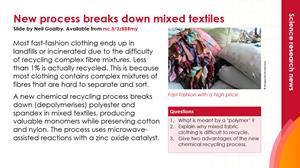Chemical approach could slash environmental harm caused by fast fashion
-

Download this
Use this story and the accompanying summary slide for a real-world context when studying polymers and recycling with your 14–16 learners.
Download the story as MS Word or PDF and the summary slide as MS PowerPoint or PDF.
A new recycling method transforms polyester and spandex into reusable monomers while leaving cotton and nylon intact. This method could offer a way to decrease the environmental impact of textile waste.
Fast fashion trends have caused a surge in textile production, with around 100 billion items of clothing now manufactured annually. The short lifespan of low-cost clothing items has a serious impact on the environment. ‘Fast fashion [contributes] to an estimated 92 million tons of textile waste globally annually,’ says Erha Andini from the University of Delaware, US.

Currently, less than 1% of textile waste is recycled, with most ending up in landfills or incinerators. This is because although mechanical and chemical textile recycling technologies exist, most clothing items contain complex mixtures of fibres that are very hard to separate and sort.
Mixing it up
Now, Erha and her colleagues have developed a simple and fast chemical recycling method that they have applied to the most common types of mixed textiles.
The team tried the method on polycotton first. They placed the fibre in ethylene glycol, added a catalyst and heated the mixture for around 15 minutes in the microwave. The polyester broke down into a monomer that they can polymerise again to remake polyester, while the cotton remained largely unchanged.
Next, the team demonstrated their approach on a complex mixture of polyester, cotton, spandex and nylon. The polyester and spandex both broke down into useful monomers and the team separated out the intact cotton and nylon. They then dissolved the nylon in acid to separate it from the cotton.
The team suggests that a refined version of their process could enable the recycling of up to 88% of global textiles. But they admit that challenges lie ahead, including dealing with the impact of dyes and finishes on the viability of the recycling process and ensuring it is economically viable.
This article is adapted from Tosin Thompson’s in Chemistry World.
Nina Notman
Reference
E Andini et al, Sci. Adv., 2024, doi.org/10.1126/sciadv.ado6827
Download
Summary slide with questions and the article for context when teaching 14–16 lessons on polymers and recycling.
Downloads
Recycling fast fashion summary slide
PDF, Size 0.43 mbRecycling fast fashion summary slide
PowerPoint, Size 2.09 mbRecycling fast fashion student sheet
PDF, Size 0.23 mbRecycling fast fashion student sheet
Word, Size 0.93 mb











No comments yet